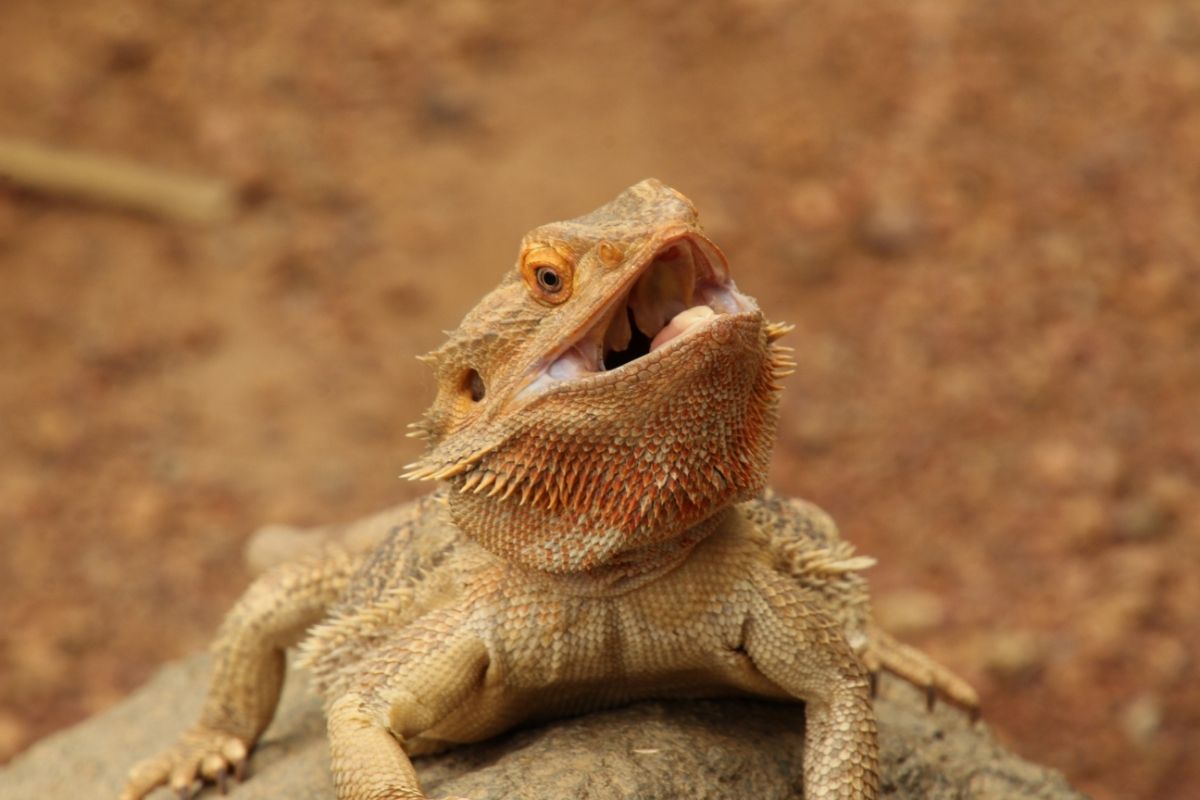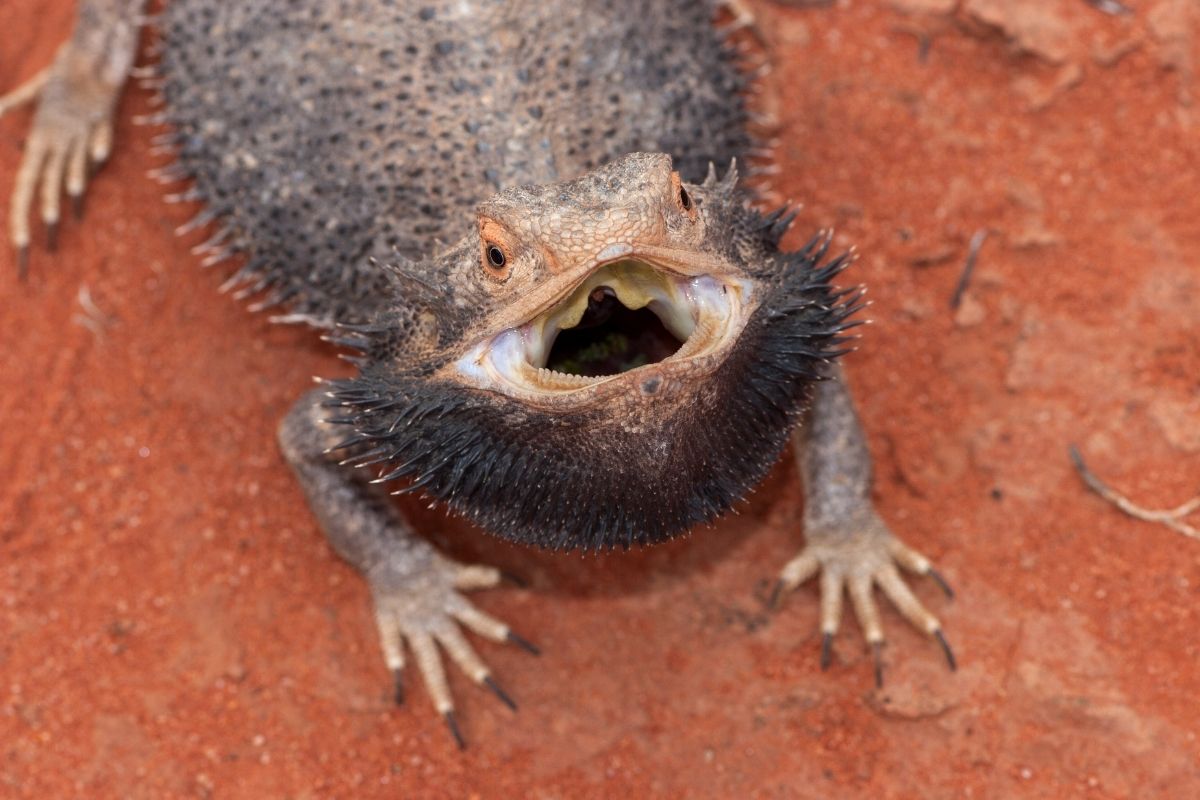Despite being one of North America’s most popular lizard pets, bearded dragons aren’t the easiest to look after.
They still have regular health problems like any other living creature.

One such problem that commonly befalls the bearded dragon is mouth rot.
Bearded dragons use their mouths for what’s most important to them: eating.
Therefore, it’s vitally important that you know how to recognize mouth rot in your bearded dragon and can get it taken care of quickly to ensure your little friend stays in good health.
In this article, we’ll be taking a look at exactly what mouth rot is, how to recognize it, and how you can treat it at home!
What Is Mouth Rot?
Mouth rot is an infection that occurs when bacteria get into the bearded dragon’s mouth.
The bacteria then starts growing inside the mouth, causing swelling and inflammation.
The bacteria also cause the skin around the mouth area to become red and swollen.
It may even cause the tongue to turn black or dark blue.
Mouth rot is a common problem for bearded dragons.
This condition causes their mouths to become swollen and painful.
If left untreated, it can cause serious health problems such as malnutrition and even death.
Bearded dragons are very susceptible to mouth rot because their teeth are a little different from most other animals.
They rely more on their tongues to eat and drink.
When they bite down on food, the pressure of their jaw pushes against the roof of their mouth, allowing bacteria to enter.
Telltale Signs Of Mouth Rot In Bearded Dragons
Thankfully, your bearded dragon will give some pretty clear indications if they are suffering from mouth rot.
These are some things you should be looking out for:
Lack Of Appetite
Generally, bearded dragons love eating more than anything else.
This makes it very easy to identify when they’re not eating as much as they normally would.
When suffering from mouth rot, eating becomes somewhat painful and unpleasant for bearded dragons.
Therefore, even though they love doing it, they’ll avoid eating as much food and allow any live insects you put in their tank to run around freely.
Loose Or Broken Teeth
If you notice that your bearded dragon has loose or broken teeth, you need to take action immediately.
As mentioned earlier, the pressure of their jaws pushing against the roof of their mouths allows bacteria to enter through the gaps between their teeth.
This means that if your bearded dragon has lost their teeth, there’s a greater chance that they’re going to suffer from mouth rot.
Patches Of Rot On the Oral Cavity
Another sign that your bearded dragon might be suffering from mouth rot is patches of rot on its oral cavity.
Although these patches don’t necessarily mean that your bearded dragon is already sick, they do indicate that something isn’t right with its mouth.
These patches will often be pretty clear to see because they’ll be a distinctly different color from the rest of your bearded dragon’s skin.
Look out for yellow/gray patches on the inside of your pet’s mouth.
Bloating
You might think that a loss of appetite would cause your bearded dragon to shrink in size, but bloating is actually a common symptom of mouth rot.
Therefore, if you see your bearded dragon getting bigger and puffier but isn’t eating as much as they normally do, it might be time to take them to the vet.
Bleeding Gums
As well as being able to spot the signs of mouth rot, you can also tell by how your bearded dragon’s gums look.
It’s the same symptom as with humans, really.
If a human’s oral hygiene is poor, a symptom might be bleeding gums, and the same is true with bearded dragons.
How To Treat Mouth Rot In Bearded Dragons

The best thing you can do for your bearded dragon is to get them to the vet as soon as possible.
The sooner you act, the better.
Unfortunately, this won’t always work.
Sometimes, your bearded dragon will have developed mouth rot so badly that it might be too late.
That’s why it’s so important to keep an eye on the signs we’ve listed above.
However, to combat the early signs of mouth rot, there is also a treatment you can perform at home to keep your little buddy’s mouth clean:
Home Remedy For Mouth Rot
Before we explain this home remedy, please bear in mind that this will only be effective against the really early signs of mouth rot, and you should always take your bearded dragon to a vet if you think they’re suffering.
First, you’ll need to get a hold of some antiseptic or disinfectant like Betadine or Nolvasan.
Dilute the chemical in a cup of water until you’ve broken the solution up completely.
Then, dab one end of a cotton bud or Q-tip in the solution so you can administer it to your bearded dragon.
Gently rub the solution onto the affected area of your bearded dragon’s mouth and keep dipping the cotton bud/Q-tip back into the solution as necessary.
Once you’re sure you’ve covered the affected part of your bearded dragon’s mouth with the solution, it’s time to rinse that area off with some water.
If you have a small pipette, you could use this to squirt the water into their mouth, but you can just as easily use a wet cloth to rub it off.
Repeat this process a couple of times throughout the day, and make sure you keep checking up on your bearded dragon afterward.
By the next day, if the symptoms still haven’t cleared up, it’s definitely time for a visit to the vet.
How To Prevent Mouth Rot In Bearded Dragons
Of course, it’s much better to prevent mouth rot altogether in your bearded dragon than to have to treat it after the fact.
To help prevent mouth rot, keep your bearded dragon in a clean environment with plenty of fresh water.
Make sure there are no cracks or crevices where dirt can get into the tank.
Clean out any debris from the filter regularly.
You can also use a reptile-safe cleaner like Fluker’s to remove any dead skin cells from the lizard’s body.
Fluker’s food is also available at Chewy.com.
5 Top Tips On Caring For Your Bearded Dragon
A bearded dragon (Pogona vitticeps) is one of the most popular lizards sold at pet stores.
These animals are native to Australia but are now being bred throughout North America.
The bearded dragon is different from some other types of lizards and belongs to the agamid lizard family.
However, it looks similar to a monitor lizard and is often referred to as a “bearded” monitor.
The bearded dragon is actually quite docile, although it does have a reputation for being aggressive toward people who handle them roughly.
This animal is best kept alone unless you want to share its space with another pet.
However, this doesn’t mean that you should leave your bearded dragon unattended all day long.
It needs time to exercise and play, just like any other pet.
Here are some things you need to know about caring for a bearded dragon:
Food & Water
Just like any other pet, your bearded dragon will require two main sources of nutrition: food and water.
Food is what keeps your lizard healthy and happy.
There’s no wrong or right answer when it comes to which food is best, and any kind of small, live insects and vegetables will go down a treat.
You’ll need to provide him with a diet high in protein and low in carbohydrates.
He will also need vitamins and minerals.
You can find commercial foods specifically designed for bearded dragons online (Amazon & Chewy) or in pet shops.
Some of these contain ingredients that may affect your lizard if he eats too much of them.
However, you can make your own diet using natural foods.
Just remember that it won’t be as nutritious as commercially prepared diets.
Bearded dragons don’t usually need a lot of water.
In fact, they’re able to survive without drinking for up to three days.
However, they do need access to fresh water every few hours.
If you’ve got a large aquarium, you might consider adding a sump pump so that your bearded dragon always has clean water available.
Temperature

Your bearded dragon will thrive in temperatures between 65 °F and 80 °F.
Keep him or her away from direct sunlight during hot weather.
The heat could cause their scales to crack and become brittle.
Lighting
Bearded dragons love bright light and will quickly adjust to dimmer lighting conditions.
If you have an indoor bearded dragon, you shouldn’t worry about keeping it in total darkness
Grooming
Grooming your bearded dragon isn’t necessary, but it will help keep his skin looking healthy and shiny.
Use a soft brush and some lizard-friendly cleaning solution to gently remove dead skin and dirt from your lizard’s body.
Health Checkups
Regular health checks are important because your bearded dragon may suffer from certain diseases or parasites.
To check on your bearded dragon’s overall health, look over his eyes, mouth, gums, throat, chest, belly, feet, tail, and genitals.
Look out for signs such as lumps, rashes, discharge, swelling, bleeding, and scabs.
Frequently Asked Questions
Does Mouth Rot Go Away Over Time?
Unfortunately, mouth rot isn’t the sort of thing that just goes away if you leave it long enough.
The most common treatments involve antibiotics, thorough cleaning, or even a minor surgical procedure.
Is Mouth Rot Painful For Bearded Dragons?
Mouth rot can be quite painful for bearded dragons.
They’ll mostly feel the effects while they’re eating food.
Otherwise, it won’t cause them too much distress at first.
However, the condition will worsen over time, so getting it treated by a vet as soon as possible is important to avoid putting your pet through discomfort or pain.
Can Humans Get Mouth Rot?
Humans can’t get the same kind of mouth rot as lizards like bearded dragons.
However, a condition known as trench mouth is known to occur in teenagers and younger adults.
It’s still a very rare disease that tends only to affect those in poor living conditions.
Conclusion
Bearded dragons are thought of as pretty easy pets to take care of, but that doesn’t mean you should neglect to look after their oral health.
Hopefully, with the knowledge you’ve gained from this article, your own bearded dragon will have the healthiest mouth in town!
